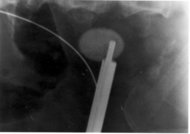Up to 12 percent of the population will have a urinary tract stone at least once, and the likelihood of stone recurrence is about 50 percent. Teichman reviews the diagnostic work-up and management of patients with this common condition.
The typical presenting symptom of a renal stone is acute, colicky f lank pain that radiates to the groin. As the stone drops from the renal pelvis, down the ureter to the ureterovesical junction, most patients have dysuria, and urinary urgency and frequency. About 90 percent of patients with urolithiasis have at least microscopic hematuria.
Intravenous urography is no longer the gold standard for diagnosing urolithiasis. Unenhanced helical computed tomographic (CT) scanning has been shown to have higher sensitivity and specificity for stone detection. CT scans have the additional benefit of identifying other causes of abdominal pain when a stone is not present. Ultrasonography has much lower sensitivity for finding stones, but it is the preferred imaging modality in pregnant women.
Typically, urgent intervention is not indicated for urolithiasis, but it may be necessary if the upper urinary tract is obstructed and infected, the renal function is compromised, or there is intractable pain or vomiting. Most patients are managed expectantly with analgesics for pain relief. The author notes that no randomized studies have compared narcotics with nonsteroidal anti-inflammatory drugs (NSAIDs) for pain relief in renal colic, but they appear to have roughly equal efficacy. If an NSAID is chosen, intravenous ketorolac provides more rapid pain relief than oral dosing. The likelihood of spontaneous stone passage is directly related to the size of the stone and the time needed for passage. If no stone movement has occurred after a month, intervention is warranted because the incidence of complications (e.g., renal deterioration, sepsis, ureteral stricture) is increased.
Uric acid stones are amenable to medical management by alkalinizing the urine with oral supplements of potassium citrate, which dissolves the stone. Other metabolic factors that are associated with stone formation include low urinary volume, hypercalciuria, and hypocitraturia.
When intervention is required, shock-wave lithotripsy often is used to break up proximal ureteral stones less than 1 cm in diameter. For larger stones or those more distal in the ureter, ureteroscopy or lithotripsy may be used. Ureteroscopes with laser tips can photothermally disrupt stones. Laser stone ablation is less expensive than lithotripsy, but it is technically more demanding and time consuming.
BILL ZEPF, M.D.
Teichman JM. Acute renal colic from ureteral calculus. N Engl J Med February 12, 2004;350:684-93.
COPYRIGHT 2004 American Academy of Family Physicians
COPYRIGHT 2004 Gale Group



